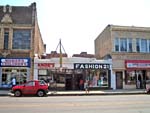|
|
|
|
.
|
|
|
|
.
Chicago
(800N/1700W)
Chicago Avenue and Paulina
Street, West Town
Service Notes:
Logan Square Line
Quick Facts:
Address: 1714-16 W. Chicago Avenue
Established: May 6, 1895
Original Line: Metropolitan West Side Elevated, Northwest branch
Previous Names: n/a
Skip-Stop Type: n/a
Rebuilt: n/a
Status: Demolished
History:
The Chicago station was opened in 1895 as part of the initial stretch of the Met's Northwest branch.
Chicago station consisted of a station house at street level and dual side platforms at track level. The station house was probably typical of the Met designs on the Northwest and Garfield Park branches. Constructed of red pressed brick with stone sills and foundations, their vernacular style might best be described as Queen Anne-influenced with some Romanesque features. The stations' original design was highlighted by a semicircular bay/portico, a lattice pattern in the brick cornice, extensive terra cotta work including the word "entrance" above one door in the portico and "exit" above the other, dentals above the doors' story lights, and carved wooden beads flush with the building between the wooden brackets which support a wooden canopy over the portico.
The stations' dual side platforms had canopies and railings typical of all Met stations: Designed into the railings were larger cast iron square plates with a stylized diamond design. Each platform had a short canopy in the center of the platform, covering the stairs and a small waiting area. The canopy frame was iron, with arched latticed supports and bracketed rafters, and hipped roofs of corrugated tin.
Chicago was closed February 25, 1951 when the Logan Square branch of the former Metropolitan "L" was rerouted through the Milwaukee-Dearborn Subway. The north-south portion of the old Northwest branch -- which became known as the Paulina Connector after revenue service was suspended on it -- was retained for car transfers and other nonrevenue car moves for over a decade. The old stations along the Connector were no longer needed, so all wood was removed from station platforms and stairs as a fire prevention measure, and the lowest flight of stairs was completely removed at each station to avoid trespassing, but otherwise the stations were left pretty much intact for several years. In August 1964, it was decided to remove the portion of the Paulina Connector between Washington Junction and Evergreen Junction from service in preparation for demolition. Actual demolition may not have occurred until about 1968.
A commercial building built by the Chicago Rapid Transit Company across the street from the station, underneath the "L" tracks, was left intact. Even after the elevated structure was removed in the 1960s, the commercial building was left in place. Located at 1717 W. Chicago Avenue, it is still in existence today.
|
|
This Chicago-L.org article is a stub. It will be expanded in the future as resources allow. |
 |
chicago01.jpg
(146k) |
|
|